10 Tips for Creating an Agile Product Strategy with the Vision Board
Join the DZone community and get the full member experience.
Join For Free1 Start with What You Know Now
Traditionally, a product strategy is the result of months of market research and business analysis work. It is intended to be factual, reliable, and ready to be implemented. But in an agile, dynamic environment a product strategy is best created differently: Start with your idea, state the vision behind it, and capture your initial strategy. Then identify the biggest risk or the crucial leap-of-faith assumption, address it, and change and improve your strategy. Repeat this process until you are confident that your product strategy is valid.

This iterative approach, piloted by Lean Startup, helps you acquire the new knowledge fast and in a goal-oriented, focused manner addressing the key risks or assumptions. It avoids the danger of carrying out too much and too little research, reduces time-to-market, and increases your chances of creating a successful product.
2 Focus on what Matters Most
The term product strategy means different things to different people, and strategies come in different shapes and sizes. While that’s perfectly fine, an initial product strategy that forms the basis for subsequent correction and refinement cycles should focus on what matters most: the market, the value proposition, the product’s unique selling points, and the business goals. This is where my Vision Board comes in. I have designed it as the simplest thing that could possibly work to capture the vision and the product strategy. You can download it from romanpichler.com/tools/vision-board for free.
For an introduction to the Vision Board, please see my post “The Product Vision Board”.
3 Create the Product Strategy Collaboratively
A great way to create your product strategy is to employ a collaborative workshop. Invite the key people required to develop, market, sell and service your product and the senior management sponsor. Such a workshop generates early buy-in, creates shared ownership, and leverages the collective knowledge and creativity of the group. Selling an existing vision and product strategy can be challenging. Co-creation is often the better option.
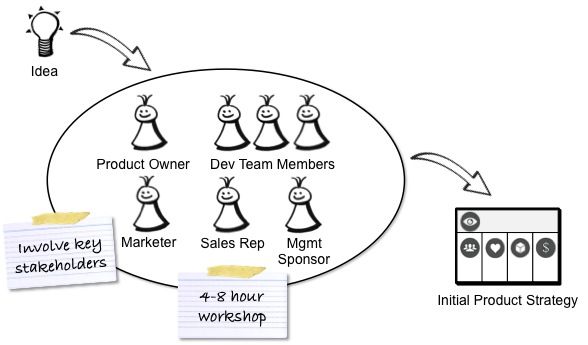
Your initial Vision Board has to be good enough to create a shared understanding of your vision and initial strategy and to identify the biggest risk so you can start re-working your board. But don’t spend too much time on it and don’t try to make it perfect. Your board will change as you correct, improve and refine it.
4 Let your Vision Guide you
The product vision is the very reason for creating your product: It describes your overarching goal. The vision also forms the basis of your product strategy as the path to reach your overall goal. As the vision is so important, you should capture it before you describe your strategy.
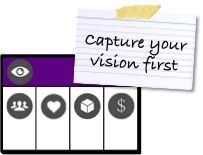
Here are four tips to help you capture your vision:
- Make sure that your vision does not restate your product idea but goes beyond it. For instance, the idea for this post is to write about creating an agile product strategy, but my vision is to help you develop awesome and successful products.
- Choose a broad vision, a vision that engages people and that enables you to pivot – to change the strategy while staying true to your vision.
- Make your vision statement concise; capture it in one or two sentences; and ensure that it is clear and easy to understand.
- Try to come up with a motivating and inspiring vision that helps unite everyone working on the product. Choosing an altruistic vision, a vision that focuses on the benefits created for others, can help you with this.
5 Put the Users First
Once you have captured your vision, work on your strategy by filling in the lower sections of the Vision Board from left to right. Start with the “Target Group”, the people who should use and buy your product rather than thinking about the cool, amazing product features or the smart business model that will monetise the product. While both aspects are important, capturing the users and customers and their needs forms the basis for making the right product and business model decisions.

While it’s tempting to think of all the people who could possibly benefit from your product, it is more helpful to choose a clear-cut and narrow target group instead. Describe the users and customers as clearly as you can and state the relevant demographic characteristics. If there are several segments that your product could serve then choose the most promising one.
Working with a focused target group makes it easier to test your assumptions, to select the right test group and test method, and to analyse the resulting feedback and data. If it turns out that you have picked the wrong group or made the segment is too small then simply pivot to a new or bigger one. A large or heterogeneous target group is usually difficult to test. What’s more, it leads to many diverse needs, which make it difficult to determine a clear and convincing value proposition and therefore to market and sell the product.
6 Clearly State the Main Problem or Benefit
Once you have captured your target users and customers, describe their needs. Consider why they would purchase and use your product. What problem will your product solve, what pain or discomfort will it remove, what tangible benefit will it create?
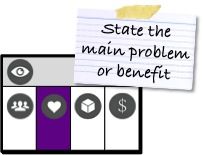
If you identify several needs, then determine the main problem or the main benefit, for instance, by putting it at the top of the section. This helps you test your ideas and create a convincing value proposition. I find that if I am not able to clearly describe the main problem or benefit, I don’t really understand why people would want to use and to buy a product.
7 Describe the Essence of your Product
Once you have captured the needs, use the “Product” section to describe your actual product idea. State the three to five key features of your product, those features that make the product desirable and that set it apart from its competitors. When capturing the features consider not only product functionality but also nonfunctional qualities such as performance and interoperability, and the visual design.
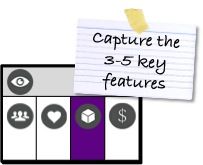
Don’t make the mistake of turning this section into a product backlog. The point is not to describe the product comprehensively or in a great amount of detail but to identify those features that really matter to the target group.
8 State your Business Goals and Key Business Model Elements
Use the “Value” section to state your business goals such as creating a new revenue stream, entering a new market, meeting a profitability goal, reducing cost, developing the brand, or selling another product. Make explicit why it is worthwhile for your company to invest in the product. Prioritise the business goals and state them in the order of their importance. This will guide your efforts and help you choose the right business model.
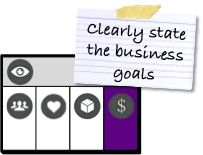
Once you have captured the business goals, state the key elements of your business model including the main revenue sources and cost factors. This is particularly important when you work with a new or significantly changed business model.
9 Extend your Board
The Vision Board’s simplicity is one of its assets, but it can sometimes become restricting: The Product and the Value sections can get crowded as the board does not separately capture the competitors, the partners, the channels, the revenue sources, the cost factors, and other business model elements. Luckily there is a simple solution: Extend your board and add further sections, for instance, “Competitors”, “Channels”, “Revenue Streams”, and “Cost Factors”, or download an extended version from my website.

But before using an extended Vision Board make sure that you understand who your customers and users are and why they would buy and use the product. There is no point in worrying about the marketing and the sales channels or the technologies if you are not confident that you have identified a problem that’s worthwhile addressing. Additionally, a more complex board usually contains more risks and assumptions. This makes it harder to identify the biggest risk and leap-of-faith assumption.
10 Put it to the Test
Capturing your vision and initial product strategy on the Vision Board is great. But it’s only the beginning of a journey in search of a valid strategy, as your initial board is likely to be wrong. After all, you have based the board on what you know now rather than extensive market research work.
You should therefore review your initial Vision Board carefully, identify its critical risks or leap-of-faith assumptions, and select the most crucial risk or assumption. Determine the right test group, for instance, selected target users, and the right test method such as problem interviews. Carry out the test, analyse the feedback or data collected, and change your Vision Board with the newly gained knowledge as the picture below shows.

If you find that the key risks and assumptions hard to identify then your board may be too vague. If that’s the case then narrow down the target group, select the main problem or benefit, reduce the key features to no more than five, identify the main business benefit, and remove everything else.
Your board may significantly change as you iterate over your strategy, and you may have to pivot, to choose a different strategy to make your vision come true. If your Vision Board does not change at all then you should stop and reflect: Are you addressing the right risks in the right way and are you analysing the feedback and data effectively?
Published at DZone with permission of Roman Pichler, DZone MVB. See the original article here.
Opinions expressed by DZone contributors are their own.


Comments